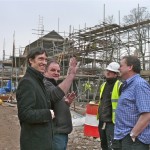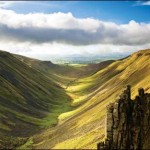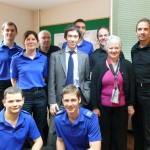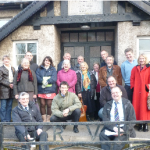innovia and wigton
When I ran last week from parliamentary meetings about the Cumbrian sewage system; to the Olympics; the Forestry Commission; army reforms; and rural planning guidelines, I found myself struggling to keep up with it all. Learning about new policy areas can be bewildering and dispiriting. Officials scatter jargon: yesterday, SME didn’t mean Small and Medium Sized Enterprise but ‘Subject Matter Expert’. Lobbyists cite little known committees and policy wonks recite statistics. Everyone makes lofty mission statements. It took me ten minutes of repeated questioning, for example, to understand that a charity which described itself as ‘addressing urban regeneration and youth opportunity, through accountable and creative approaches to social inclusion’ was in fact restoring a community hall. You are always trying to guess what is not being said: to spot the other side of the story. It is difficult to learn through such briefings.
Seeing a project on the ground feels different. Last week, for example, I visited the Innovia film factory in Wigton. None of my meetings with management had prepared me for the factory itself. We moved in white coats and glasses between buildings which seemed fit for NASA. One was filled with great waterfalls of moving viscose and a whiff of sulphur. It took a half-hour walk down a four story tower to watch the transformation of resin pellets into polymer film for me to begin to follow the process. I thought, for example, that he said the polymer passed through a ‘dye’ and could not understand how colour defined the shape of the film. And once I realised he had said ‘die’, I still struggled to visualise how a flat metal press could shape a bubble and why it was necessary to heat, cool and heat the same material again.
But the visit wasn’t only a chemistry lesson, it was an economics lesson. Before I visited, I couldn’t understand Innovia’s success. Its energy costs were high. Ninety per cent of Innovia’s film was exported and it was not even near a motorway, let alone an airport. They relied on a thousand workers and engineers and they were competing with Asian countries, which have low wages and a far larger pool of engineers. Innovia had not retired all their old technology, out-sourced their research, dramatically cut staff numbers or bought state-of-the art computerised robots for cutting. Instead, they had kept a generously sized research and development team and built much of their machinery in-house. Instead of retiring lines they had kept their cellulose plant and their bubble mould far longer than their competitors. Instead of using computerised machines, they used people (more people were employed in cutting than in making the film itself).
But as I walked I saw how these characteristics, which I thought were problems, were in fact part of Innovia’s extraordinary success. By keeping the cellulose and bubble moulds, when others haven’t, they can use these now rare technologies for fashionable purposes (cellulose can make biodegradable film, bubble moulds can make thicker film). Human cutters have allowed them to adapt to different size orders far more cheaply and efficiently than a computer. As a result, they are the only cellophane plant to survive in Europe (from twenty in the 1980s) and they are the world leader, or the second in the world, in every one of their products from polymer banknotes to transparent pressure-fixed labels (they make the Appletise labels for example). This is what makes them the largest, most profitable international export company in the constituency and the life-blood of Wigton.
But government is not helping. The Chief Executive showed me that he had just been hit with a half million pound extra energy bill: this is because of lack of national investment in energy generation (the country as a whole needs hundreds of billions of energy investment). A cutter explained how the lack of bus services was making it impossibly difficult for his son to commute to the factory. Tom, who had started as an apprentice, confirmed that English schools are now producing too few good engineers.
Innovia is one of a hundred things in Cumbria which I need to understand. In the last three months, I have been looking at broadband and gypsy fairs; solar panels and affordable housing; care homes and the haulage industry; milking machines and fuel poverty; European grants and tourist information centres; war veterans and supermarkets; pub buy-outs and the probation service; industrial parks and national parks. Each Cumbrian encounter shifts my view of government policy. But when I sit in those meetings in London listening to the statistics and the action plans of senior officials, guessing whether they were misleading me or misleading themselves, I feel paralysed in a web of official concepts. Walking the ground in Cumbria is different. The Innovia visit was not just an insight into an extraordinary local company: it revealed in ways no briefing could, the contradictions in government policy on education, the environment, the economy and energy. The politician’s best hope is to take these very local and particular encounters and hurl them like a grenade at the policy centre.







